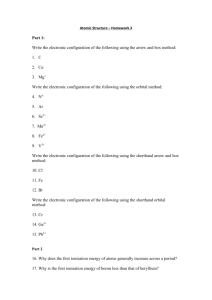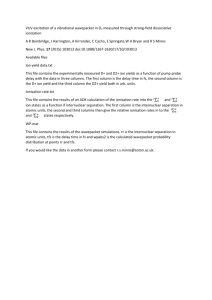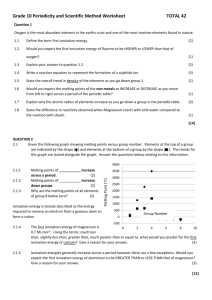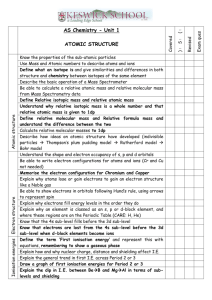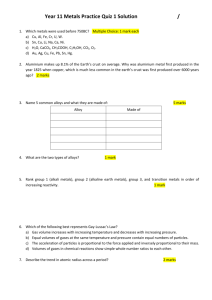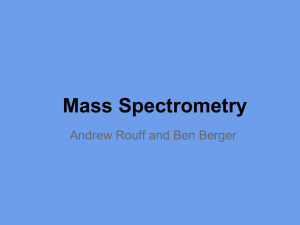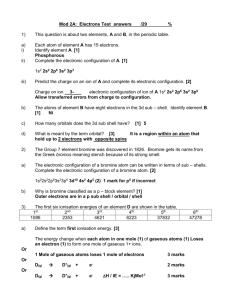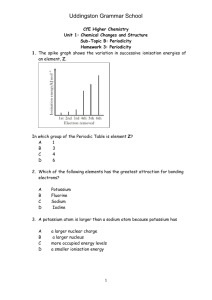Topic 1 Assessed Homework 1 - A
advertisement
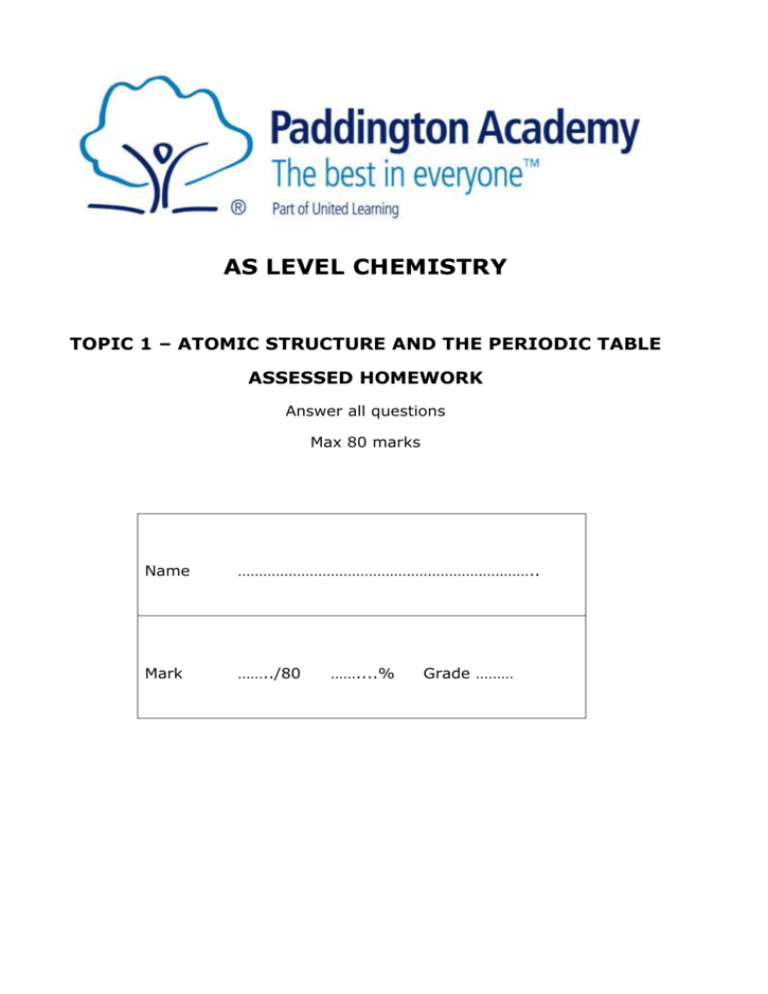
AS LEVEL CHEMISTRY TOPIC 1 – ATOMIC STRUCTURE AND THE PERIODIC TABLE ASSESSED HOMEWORK Answer all questions Max 80 marks Name …………………………………………………………….. Mark ……../80 ……....% Grade ……… 1. A naturally occurring sample of the element boron has a relative atomic mass of 10.8. In this sample, boron exists as two isotopes, 10B and 11B (i) Calculate the percentage abundance of 10B in this naturally occurring sample of boron. ............................................................................................................... ............................................................................................................... ............................................................................................................... ............................................................................................................... ............................................................................................................... (2) (ii) State, in terms of fundamental particles, why the isotopes 10B and 11B have similar chemical reactions. ............................................................................................................... ............................................................................................................... ............................................................................................................... (1) (Total 3 marks) 2. (a) State the meaning of the term mass number of an isotope. ........................................................................................................................ ........................................................................................................................ ........................................................................................................................ (1) (b) Give the symbol of the element that has an isotope with a mass number of 68 and has 38 neutrons in its nucleus. ........................................................................................................................ (1) (c) In a mass spectrometer, the isotopes of an element are separated. Two measurements for each isotope are recorded on the mass spectrum. State the two measurements that are recorded for each isotope. Measurement 1 .................................................................................... Measurement 2 .................................................................................... (2) (d) A sample of element R contains isotopes with mass numbers of 206, 207 and 208 in a 1:1:2 ratio of abundance. (i) Calculate the relative atomic mass of R. Give your answer to one decimal place. ............................................................................................................... ............................................................................................................... ............................................................................................................... ............................................................................................................... ............................................................................................................... (3) (ii) Identify R. ............................................................................................................... (1) (iii) All the isotopes of R react in the same way with concentrated nitric acid. State why isotopes of an element have the same chemical properties. ............................................................................................................... ............................................................................................................... (1) (Total 9 marks) 3. (a) A sample of sulfur consisting of three isotopes has a relative atomic mass of 32.16. The following table gives the relative abundance of two of these isotopes. Mass number of isotope 32 33 Relative abundance / % 91.0 1.8 Use this information to determine the relative abundance and hence the mass number of the third isotope. Give your answer to the appropriate number of significant figures. Mass number = ................................ (4) (b) Describe how ions are formed in a time of flight (TOF) mass spectrometer. ........................................................................................................................ ........................................................................................................................ ........................................................................................................................ ........................................................................................................................ ........................................................................................................................ (2) (c) A TOF mass spectrometer can be used to determine the relative molecular mass of molecular substances. Explain why it is necessary to ionise molecules when measuring their mass in a TOF mass spectrometer. ........................................................................................................................ ........................................................................................................................ ........................................................................................................................ ........................................................................................................................ ........................................................................................................................ (2) (Total 8 marks) 4. The element rubidium exists as the isotopes 85Rb and 87Rb (a) State the number of protons and the number of neutrons in an atom of the isotope 85Rb Number of protons ......................................................................................... Number of neutrons ....................................................................................... (2) (b) Explain how the gaseous atoms of rubidium are ionised in a mass spectrometer ............................................................................................................... ............................................................................................................... ............................................................................................................... ............................................................................................................... (2) (c) (i) State the block of elements in the Periodic Table that contains rubidium. ............................................................................................................... (1) (ii) Deduce the full electron configuration of a rubidium atom. ............................................................................................................... (1) (d) A sample of rubidium contains the isotopes 85Rb and 87Rb only. The isotope 85Rb has an abundance 2.5 times greater than that of 87Rb Calculate the relative atomic mass of rubidium in this sample. Give your answer to one decimal place. ........................................................................................................................ ........................................................................................................................ ........................................................................................................................ ........................................................................................................................ (3) (e) By reference to the relevant part of the mass spectrometer, explain how the abundance of an isotope in a sample of rubidium is determined. Name of relevant part .................................................................................... Explanation .................................................................................................... ........................................................................................................................ ........................................................................................................................ (2) (Total 11 marks) 5. The element nitrogen forms compounds with metals and non-metals. (a) Nitrogen forms a nitride ion with the electron configuration 1s2 2s2 2p6 Write the formula of the nitride ion. ........................................................................................................................ (1) (b) An element forms an ion Q with a single negative charge that has the same electron configuration as the nitride ion. Identify the ion Q. ........................................................................................................................ (1) (Total 2 marks) 6. Lithium hydride, LiH, is an ionic compound containing the hydride ion, H– Give the electronic configuration of the hydride ion, H– ...................................................................................................................... (1) (Total 1 marks) 7. There is a general trend in the values of the first ionisation energies of the elements Na to Ar. The first ionisation energies of the elements Al and S deviate from this trend. (a) Write an equation, including state symbols, to represent the process for which the energy change is the first ionisation energy of Na. ...................................................................................................................... (2) (b) State and explain the general trend in the values of the first ionisation energies of the elements Na to Ar. Trend ........................................................................................................... Explanation .................................................................................................. ...................................................................................................................... ...................................................................................................................... (3) (c) State how, and explain why, the values of the first ionisation energies of the elements Al and S deviate from the general trend. How the values deviate from the trend ......................................................... Explanation for Al ......................................................................................... ...................................................................................................................... Explanation for S .......................................................................................... ...................................................................................................................... (5) (Total 10 marks) 8. (a) What is meant by the term first ionisation energy? ...................................................................................................................... ...................................................................................................................... (2) (b) The diagram below shows the variation in first ionisation energy across Period 3. (i) What is the maximum number of electrons that can be accommodated in an s sublevel? ............................................................................................................. ............................................................................................................. (ii) What evidence from the diagram supports your answer to part (d)(i)? ............................................................................................................. ............................................................................................................. (iii) What evidence from the diagram supports the fact that the 3p sub-level is higher in energy than the 3s? ............................................................................................................. ............................................................................................................. (iv) What evidence from the diagram supports the fact that no more than three unpaired electrons can be accommodated in the 3p sub-level? ............................................................................................................. ............................................................................................................. ............................................................................................................. (5) (Total 7 marks) 9. (a) Use your knowledge of electron configuration and ionisation energies to answer this question. The following diagram shows the second ionisation energies of some Period 3 elements. (i) Draw an ‘X’ on the diagram to show the second ionisation energy of sulfur. (1) (ii) Write the full electron configuration of the Al2+ ion. ............................................................................................................... (1) (iii) Write an equation to show the process that occurs when the second ionisation energy of aluminium is measured. ............................................................................................................... (1) (iv) Give one reason why the second ionisation energy of silicon is lower than the second ionisation energy of aluminium. ............................................................................................................... ............................................................................................................... ............................................................................................................... (1) (b) Predict the element in Period 3 that has the highest second ionisation energy. Give a reason for your answer. Element ........................................................................................................ Reason ......................................................................................................... ........................................................................................................................ ........................................................................................................................ (2) (c) The following table gives the successive ionisation energies of an element in Period 3. Ionisation energy / kJ mol−1 First Second Third Fourth Fifth Sixth 786 1580 3230 4360 16100 19800 Identify this element. ........................................................................................................................ (1) (d) Explain why the ionisation energy of every element is endothermic. ........................................................................................................................ ........................................................................................................................ ........................................................................................................................ (Extra space) ................................................................................................. ........................................................................................................................ (1) (Total 8 marks) 10. The table below shows some successive ionisation energy data for atoms of three different elements X, Y and Z. Elements X, Y and Z are Ca, Sc and V but not in that order. First Second Third Fourth Fifth Sixth X 648 1370 2870 4600 6280 12 400 Y 590 1150 4940 6480 8120 10 496 Z 632 1240 2390 7110 8870 10 720 (a) Which element is calcium? X Y Z (1) (b) Which element is vanadium? X Y Z (1) (c) Justify your choice of vanadium in part (b) ........................................................................................................................ ........................................................................................................................ ........................................................................................................................ (1) (Total 3 marks) 11. This question is about the elements in Group 2 and their compounds. (a) Use the Periodic Table to deduce the full electron configuration of calcium. ........................................................................................................................ (1) (b) Write an equation to show the process that occurs when the first ionisation energy of calcium is measured. ........................................................................................................................ (1) (c) State and explain the trend in the first ionisation energies of the elements in Group 2 from magnesium to barium. Trend ............................................................................................................. Explanation .................................................................................................... ........................................................................................................................ ........................................................................................................................ ........................................................................................................................ ........................................................................................................................ ........................................................................................................................ (3) (Total 5 marks) 12. (a) Complete the electronic configuration for the sodium ion, Na+ ls2 ................................................................................................................. (1) (b) (i) Write an equation, including state symbols, to represent the process for which the energy change is the second ionisation energy of sodium. ............................................................................................................. (2) (ii) Explain why the second ionisation energy of sodium is greater than the second ionisation energy of magnesium. ............................................................................................................. ............................................................................................................. ............................................................................................................. ............................................................................................................. (3) (iii) An element X in Period 3 of the Periodic Table has the following successive ionisation energies. Ionisation energies / kJ mol–1 First Second Third Fourth 577 1820 2740 11600 Deduce the identity of element X. ............................................................................................................. (1) (c) State and explain the trend in atomic radius of the Period 3 elements from sodium to chlorine. Trend ........................................................................................................... Explanation .................................................................................................. ...................................................................................................................... ...................................................................................................................... (3) (Total 10 marks) 13. Which of these atoms has the smallest number of neutrons? A 3 B 4 C 5 D 4 H He He Li (Total 1 mark) 14. Which one of the following is a correct electron arrangement? A Cu+ is [Ar]3d94s1 B Cu is [Ar]3d104s2 C Cu2+ is [Ar]3d84s1 D Cu+ is [Ar]3d10 (Total 1 mark) 15. Which one of the following lists the first ionisation energies (in kJ mol−1) of the elements Mg, Al, Si, P and S in this order? A 577 786 1060 1000 1260 B 736 577 786 1060 1000 C 786 1060 1000 1260 1520 D 1060 1000 1260 1520 418 (Total 1 mark)
